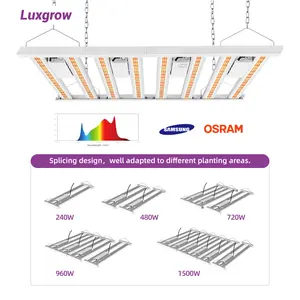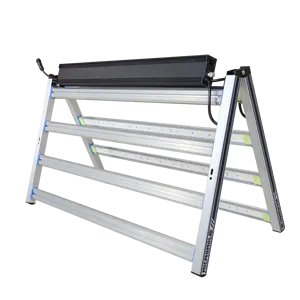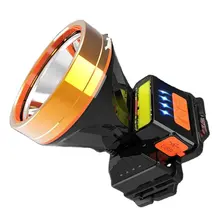A grow led is a sophisticated lighting solution designed to replicate the full spectrum of natural sunlight, fostering plant growth through various stages from seedling to bloom. Alibaba.com offers an extensive selection of LED grow lights tailored to meet the needs of indoor horticulture enthusiasts and commercial growers alike.
Types and Characteristics of LED Grow Lights
Within the category of grow lamps for plants, there are several types, each with distinct characteristics. Panel grow lights are flat and typically cover a broad area, suitable for large-scale operations. Bar lights, such as the "Flexstar Pro," are modular and can be adjusted to fit different spaces, making them versatile for various plant layouts. Bulb grow lights, or growing light bulbs, are ideal for small-scale gardeners or those just starting with indoor cultivation. These types cater to different growth stages, with some offering full spectrum led grow lights that provide a balance of cool and warm light, mimicking the natural solar spectrum to support the plant life cycle. The "Cheap Samsung lm281b Electronic LED Grow Light" series, for example, offers a range of wattages and bar configurations to suit different growing conditions, from tight spaces to expansive commercial greenhouses.
Structure and Operation of Grow LED Lights
The structure of a led grow lamp is designed to maximize light output and distribution. A typical LED grow light includes a heat sink to dissipate heat away from the LEDs, a built-in fan in some models, and a reflective casing to direct light downwards. The operation begins with an electrical current passing through the LED chip, which then emits light. The light is then focused by lenses or diffused by reflectors, depending on the design, to provide uniform light distribution suitable for plant growth. For instance, the "LED E 2*400W Grow Light" features a comprehensive kit that includes a tent for indoor cultivation, ensuring that the light is contained and utilized efficiently for plant growth.
Materials and Benefits in Grow LED Construction
The materials used in led grow lights are chosen for their durability, thermal conductivity, and aesthetic appeal. Aluminum is a common material due to its excellent heat dissipation properties, which is crucial for maintaining the longevity of the LEDs. Stainless steel may be used for its strength and resistance to corrosion, while modern plastics are selected for their versatility and cost-effectiveness. These materials ensure that the grow lights are not only functional but also fit seamlessly into various design styles, from modern urban farms to traditional greenhouses. The use of high-quality LED chips, such as the Samsung lm301h and lm301b, is a testament to the commitment to quality, ensuring high efficacy and long-term reliability.
Business Usages and Applications of LED Grow Lights
Grow lights for indoor plants have revolutionized how businesses approach plant cultivation. In vertical farming, these lights enable the growth of crops in stacked layers, maximizing space efficiency. In hydroponic stores, they provide the necessary wavelengths for plant growth without soil. The adaptability of LED grow lights has also made them invaluable in research facilities and educational institutions where precise light conditions are required for experimental growth studies. The "One Day Shipping Flexstar Pro Yields up to 4lbs" model is an example of a product that has been designed to meet the high demands of commercial growers, offering high yields and efficient energy use.
Functions and Tasks of Grow LED Lights
The primary function of a grow lamp for indoor plants is to deliver a light spectrum tailored for photosynthesis. Advanced models can simulate the gradual sunrise and sunset, reducing plant stress. Some are equipped with adjustable spectrums, which can be modified to enhance flowering or vegetative growth, depending on the plant's stage of development. The "Mars Hydroponics" series, for instance, includes lights that can be daisy-chained together, allowing for a customizable and scalable lighting solution that can grow with your plant operation.
Features and Unique Selling Points of Grow LED Lights
LED grow lights stand out with features like energy efficiency, which translates to cost savings over time. The "Mars Hydroponics" series, for example, offers lights with a high photosynthetic photon flux (PPF) value, indicating a powerful light output that can lead to more robust plant growth. Additionally, the smart features of these lights, such as programmability and connectivity with home automation systems, offer users convenience and control. The waterproof and easily assembled design of certain models makes them suitable for a variety of growing environments, from humid greenhouses to dry indoor rooms.
Benefits and Positive Outcomes of Using Grow LED Lights
Employing grow lights led full spectrum in an indoor setting can lead to multiple benefits. They can significantly increase yield and crop quality, enable year-round production, and reduce the need for chemical fertilizers and pesticides by providing optimal growing conditions, thus promoting sustainable and organic farming practices. The energy-efficient nature of LEDs also means lower operating costs and a reduced carbon footprint, making them an environmentally friendly choice for growers.
How to Choose and Use the Right LED Grow Light?
Choosing the right grow led involves assessing the specific needs of the plants, such as their light intensity and spectrum requirements. To use these lights effectively, one must understand the daily light integral (DLI) that plants need and adjust the light's height and duration accordingly. For installation, it is crucial to follow the manufacturer's guidelines to ensure proper distance from the plant canopy and avoid light burn. The "VIPAR Spectra" series, for example, offers detailed instructions and customer support to assist with setup and optimization for various plant types and growth stages.
How to Maintain and Clean LED Grow Lights?
Maintenance of led lights grow lights involves regular checks for dust and debris, which can diminish light output. Cleaning should be done with a soft, dry cloth to avoid damaging the LEDs. It's also important to ensure that the cooling systems, such as fans and heat sinks, are free from obstructions to prevent overheating. Periodic inspections can help detect any potential electrical issues early, ensuring the longevity and performance of the grow lights.
Target Audience and Customization for Grow LED Lights
The target audience for grow lights for plants ranges from hobbyists with a single grow tent to commercial growers operating large-scale greenhouses. Products like the "VIPAR Spectra" series cater to those who require high-intensity light for dense canopies, while smaller, modular systems are available for home gardeners looking to nurture a few potted plants or culinary herbs. The customization options available with these lights allow users to tailor their lighting systems to their specific needs, whether it's adjusting the light spectrum, programming light cycles, or scaling the system to match the growth of their plant operation.







































 浙公网安备 33010002000092号
浙公网安备 33010002000092号 浙B2-20120091-4
浙B2-20120091-4